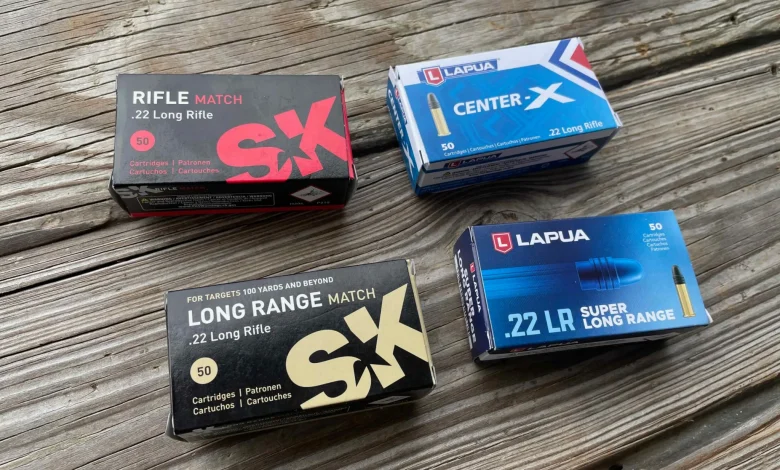Ammunition Lifespan: Key Factors to Consider

Whether you’re a casual plinker, an avid hunter, or a dedicated competitive shooter, understanding the lifespan of your ammunition is crucial. Proper storage and handling can significantly extend the life of your ammo, ensuring reliability and performance when you need it most. Let’s dive into the key factors that affect ammunition longevity across rimfire, centerfire and shotgun shells.
The Basics of Ammunition Composition
Before we get into the nitty-gritty of ammo lifespan, it’s important to understand the basic components of a cartridge. Typically, a round consists of four main parts: the case, primer, propellant and projectile. Each of these elements can be affected by various environmental factors, ultimately impacting the overall lifespan and performance of the ammunition.
Rimfire vs. Centerfire: A Tale of Two Ignition Systems
Rimfire ammunition, like the popular .22 LR, is known for its simplicity and affordability. The primer compound is distributed around the rim of the case, which is crushed by the firing pin to ignite the powder. Centerfire rounds, on the other hand, use a separate primer inserted into the center of the case head. This design difference plays a role in how these types of ammunition age and perform over time.
Rimfire Resilience
Contrary to popular belief, rimfire ammo can be surprisingly resilient when stored properly. The .22 LR cartridge, a favorite among shooters for its versatility and low recoil, can last for decades under ideal conditions. However, the integrated primer in rimfire ammo makes it somewhat more susceptible to moisture and temperature fluctuations compared to centerfire rounds.
Centerfire Longevity
Centerfire ammunition generally has a longer shelf life than its rimfire counterparts. The separate primer cup provides better protection against environmental factors, and the more robust construction of centerfire cases contributes to their longevity. With proper storage, it’s not uncommon for centerfire ammo to remain viable for 50 years or more.
Shotgun Shells: A Different Beast
Shotgun ammunition presents its own set of considerations when it comes to lifespan. The construction of shotshells, with their plastic hulls and paper or plastic wads, introduces additional variables. While modern shotgun shells are more resistant to environmental factors than their predecessors, they still require careful storage to maintain their effectiveness over time.
The Environmental Trifecta: Heat, Humidity and Light
When it comes to preserving your ammunition, three environmental factors reign supreme: heat, humidity and light. Each of these elements can wreak havoc on your ammo if left unchecked.
Temperature Troubles
Extreme temperatures, particularly heat, can accelerate the breakdown of propellants and primers. Prolonged exposure to high temperatures can cause the powder to degrade, potentially leading to inconsistent performance or even failure to fire. On the flip side, extreme cold can affect the primer’s sensitivity, though this is typically a temporary condition that resolves once the ammo returns to room temperature.
Humidity: The Silent Ammo Killer
Moisture is perhaps the most insidious threat to ammunition longevity. High humidity can lead to corrosion of the case and oxidation of the powder, compromising the structural integrity of the cartridge and the reliability of the propellant. In rimfire ammunition, moisture can also degrade the primer compound, leading to misfires or hangfires.
Let There (Not) Be Light
While not as immediately damaging as heat or humidity, prolonged exposure to light, especially UV rays, can degrade the materials used in ammunition construction. This is particularly relevant for shotgun shells with their plastic components, which can become brittle over time when exposed to sunlight.
Storage Solutions: Keeping Your Ammo in Prime Condition
Now that we’ve covered the threats to ammunition longevity, let’s talk about how to mitigate them. Proper storage is key to extending the life of your ammo and ensuring its reliability when you need it.
Climate-Controlled Comfort
The ideal storage environment for ammunition is cool, dry and dark. A climate-controlled room or closet in your home is often sufficient. Aim for a consistent temperature between 55-85°F (13-29°C) and relative humidity below 50%. Avoid storing ammo in attics, garages or basements where temperature and humidity can fluctuate wildly.
Containers and Desiccants: Your Ammo’s Best Friends
Investing in quality ammo cans or airtight plastic containers can go a long way in protecting your rounds from the elements. For an extra layer of protection, consider adding desiccant packs to your storage containers. These little moisture-absorbing packets can help maintain a dry environment, even if some humidity manages to sneak in.
Rotation and Inspection: The Shooter’s Duty
While properly stored ammunition can last for decades, it’s good practice to rotate your stock. Use your older ammo first, and periodically inspect your stored rounds for signs of corrosion, discoloration or other visible defects. This not only ensures you’re using your ammunition before it potentially degrades but also helps you catch any issues before they become problems at the range or in the field.
Performance Considerations: Age vs. Quality
It’s worth noting that even well-stored ammunition can experience some degradation over time. While this might not be noticeable for casual plinking, precision shooters and hunters should be aware that very old ammo might not perform to the same standards as fresh factory loads.
Rimfire Realities
For rimfire enthusiasts, it’s particularly important to pay attention to the performance of older ammo. The integrated primer in rimfire cartridges can become less reliable over time, even under ideal storage conditions. If you’re planning a small game hunt or a competition with your trusty .22, it might be worth chronographing some of your older stock to ensure consistent velocities.
Centerfire Confidence
Centerfire ammunition tends to age more gracefully, but it’s not immune to the effects of time. Hunters using older centerfire rounds should be particularly vigilant, as even small changes in powder performance can affect velocity and trajectory at longer ranges. When your trophy buck is on the line, it might be worth opting for newer ammo to ensure peak performance. Save the older ammo for practicing at the range.
Shotgun Shell Strategies
Shotgun shells, with their more complex construction, can be more susceptible to aging effects. The crimp on older shells may loosen over time, potentially affecting pattern consistency or allowing filler to leak out. For critical applications like waterfowl hunting or clay competitions, fresher shells are often the way to go.
The Reloading Factor: A Double-Edged Sword
For those who reload their own ammunition, there are additional factors to consider. While reloading allows for precise control over your rounds, it also introduces variables that can affect longevity. Different powders have different shelf lives and react differently to environmental conditions. Some modern powders are remarkably stable, while others may degrade more quickly. Keeping detailed records of your reloads, including the type and lot number of powder used, can help you track performance over time.
Primers are another critical component for reloaders to consider. While generally quite stable, primers can degrade over time, especially if exposed to oils or solvents. Storing primers in their original packaging, away from any chemicals, can help extend their useful life.
The Bottom Line on Ammo Longevity
When it comes to ammunition lifespan, the old adage “store it cool, dry and dark” remains the golden rule. Whether you’re preserving your rimfire plinking rounds, centerfire hunting cartridges or shotgun shells for clay sports, proper storage is key to maintaining performance and reliability.
Remember, while ammunition can last for decades under ideal conditions, it’s not immortal. Regular inspection, rotation of stock and being mindful of the age and storage history of your ammo will serve you well. When in doubt, especially for critical applications like hunting or competition, opt for newer factory loads to ensure peak performance.
By understanding the factors that affect ammunition lifespan and taking steps to mitigate them, you can ensure that your rounds will be ready when you are, whether you’re introducing a youngster to the joys of shooting with a classic .22 LR rifle, taking your centerfire rifle out for a long-range session or simply enjoying a day at the range with friends. After all, in the world of shooting sports, reliability is king, and proper ammo care is the crown jewel of preparedness.
Read the full article here






